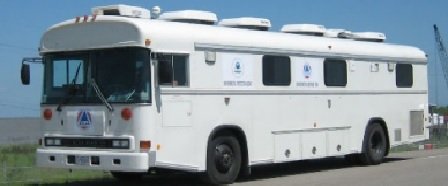Trace Atmospheric Gas Analyzer (TAGA)

The Trace Atmospheric Gas Analyzer (TAGA) is a self-contained mobile laboratory capable of real-time monitoring of outdoor air or emissions. The instrumentation refers both to the analytical instrument and the mobile laboratory built around it. The instrumentation aboard a TAGA mobile laboratory includes:
- A TAGA mass spectrometer/mass spectrometer (MS/MS), which provides real-time monitoring for many organic and inorganic compounds at the part-per-billion by volume (ppbv) levels or lower
- An Agilent gas chromatograph/mass spectrometer (GC/MS), which analyzes volatile organic compounds at the ppbv level or lower in air samples collected in Tedlar® bags using a loop injection system
- A global positioning system (GPS), which supplies accurate, real-time positional data during mobile monitoring or stationary events
- A GIS system, which maps and presents the TAGA’s position and data in real time.
- The real-time TAGA MS/MS data are available in near real-time via the VIPER system. Viper is a wireless network based communications system designed to enable near real-time transmission of data from the TAGA MS/MS, GPS and other sensors to a local computer, remote computer or enterprise server and provide data management, analysis, and visualization.
Additional instrumentation – including, but not limited to, a mercury analyzer and electrochemical sensors for gases – has been incorporated for specific programs. This versatile mobile monitoring system offers a wide variety of services to assist groups within EPA with cost-effectively conducting investigatory and enforcement activities.
TAGA laboratories have supported the Agency on numerous and varied responses, projects, developments, preparedness activities and deployments.
- Emergency Responses: the Paulsboro train derailment, Deepwater Horizon oil spill, Hart Senate Office Building anthrax fumigation, World Trade Center response.
- Vapor Intrusion Studies and Advancement of Understanding Through Field Operations: started in 1987 with the Love Canal Habitability Study. The MS/MS system can identify contributions associated with vapor intrusion from contaminated groundwater or soil as well as isolate impacts from confounding sources such as lifestyle materials, outdoor ambient air contributions and accidental/intention releases.
- Urban Air Toxics Program Studies: the program was initiated to reduce public exposure to hazardous pollutants. TAGA laboratories provided analytical support in the Baton Rouge (Louisiana), Port Arthur (Texas), and Houston Ship Channel areas.
- Fumigation Remediation Activities: building decontamination of weaponized anthrax at the Hart Senate Office Building, Brentwood and Hamilton Post Offices, Operation Lemon Drop, and the former AMI facility. TAGA monitored outdoor ambient air to ensure that public health was not impacted by the fumigant, chlorine dioxide.
- Chemical Warfare Agent (CWA) Monitoring Preparedness during a Release: the MS/MS technology was evaluated; it monitored CWAs in part per trillion by volume (pptv) levels or lower during testing at the U.S. Army’s Edgewood Chemical and Biological Center in Maryland.
- Engineering Support: analytical information provided to optimize operating parameters for remediation operations.
- Pre-deployment and Planning during Events of National Consequence: TAGA laboratories used as operational units on many occasions as assets.
Trace Atmospheric Gas Analyzer Mobile Laboratories Fact Sheet (pdf)
